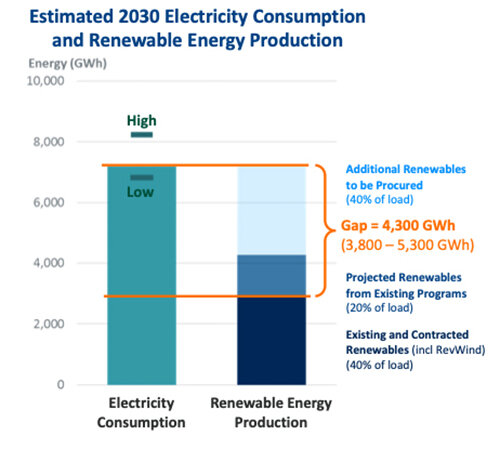Rhode Island has embarked on its goal of achieving 100 percent renewable energy by 2030. Getting there is a work in progress, but the target will likely be reached without doing much outside of existing renewable-energy initiatives and hoping that offshore wind development reaches critical mass.
Based on an Office of Energy Resources PowerPoint presentation given at a July 9 online public workshop, the state has a fairly simple math problem to solve. Rhode Island consumes about 7,200 gigawatts of electricity annually. The offshore Revolution Wind project will deliver about 1,300 gigawatts once it goes online, which is expected in 2024. Other long-term contracts the state has with power producers, like the The Gravel Pit Solar II project in East Windsor, Conn., will account for about 400 gigawatts. Net metering and the state’s fixed-price contract program will deliver some 1,200 gigawatts. That leaves about 4,300 gigawatts or about 40 percent of annual electricity consumption to be filled by the renewable power target.
The solutions under consideration by the Rhode Island Office of Energy Resources (OER) are expected to rely on renewable energy programs like the Renewable Energy Standard (RES). The state mandate requires National Grid to make annual increases in the amount of renewable energy it delivers to ratepayers. It does so by purchasing renewable energy credits (RECs) from wind turbines, solar farms, and other qualified power systems located in New England and New York.
The RES program requires that 16 percent of National Grid’s power comes from renewable sources in 2020. The target climbs about 1.5 percent annually until 2035. Increasing the RES to 100 percent by 2030 requires approval from the General Assembly. But National Grid, which holds immense influence at the Statehouse, has resisted previous efforts to raise the cap. After unsuccessful attempts over several legislative sessions, National Grid agreed in 2016 to raise the limit to the current goal of 38.5 percent.
The massive arsenal of offshore wind energy off of southern New England will likely offer an abundance of RECs. Yet, some 22 gigawatt of offshore wind projects have been in a holding pattern due to a delayed federal environmental review of the Vineyard Wind wind farm. The project is behind schedule and other wind proposals are waiting on the Bureau of Ocean Energy Management (BOEM) to set the standard for the layout of turbines and other construction and operational elements before they seek permits of their own. BOEM’s environmental report is expected in November.
There is also the risk of an oversupply of RECs stemming from the wave of new offshore wind power. If there are more RECs than needed to meet RES compliance in Rhode Island and other states, then there is less of an economic incentive to build new renewable energy projects and further reduce climate emissions.
The Brattle Group, the Cambridge Mass.-based energy consultants, are putting together energy portfolio options Rhode Island can adopt to fill its renewable energy gap.

At the July 9 kickoff for the project, Jürgen Weiss, a principal consultant with The Brattle Group, outlined the importance of addressing the use of RECs. So-called cheap RECs that come from a surge of local renewable energy or even from outside the region, he said, may hinder ”this concept of making sure that we’re incentivizing additional renewable energy resources.”
Ten years is not a lot of time to develop new renewable programs, Weiss noted. Therefore existing incentives like the RES and fixed-price power purchase contracts will likely be the primary tools to meet the “100% x ’30” goal. Meanwhile environmental equity, siting, and land-use rules, such as the protection of forestland, will be part of any conclusions and energy portfolio options.
“We need to consider the feasibility and the practicality of implementing any of these action plan items,” Weiss said.
Other elements of the report will address the cost of expanding the electricity transmission system, battery storage, and changes to the regional power grid after 2030 caused by aan expected increase in electricity use.
Nuclear power is not a likely option because of the time needed to approve, site, and build a facility by 2030. Weiss also noted that nuclear is technically not considered a renewable source of power.
“There are no plans to consider additional nuclear as part of this study and I don’t think that would be a solution for Rhode Island either, certainly at least over the next decade,” said Nicholas Ucci, commissioner of the Office of Energy Resources.
Wood-burning biomass, however, will be allowed, at least as an eligible form of electricity within the RES. Massachusetts and Connecticut, meanwhile, have restrictions on burning trees and wood byproducts for power plants due to the elevated pollution content and carbon emissions.
The report will consider the costs of expanding renewable electricity for frontline and low-income communities while balancing those costs with economic benefits such as new jobs that may improve incomes within vulnerable populations.
It’s not likely that existing fossil-fuel power plants and infrastructure like compressor stations will be shutting shut down by 2030. It’s expected that natural gas facilities will be relied on in the years ahead to serve as standby “peaker” plants that deliver electricity when wind, solar, and storage cannot meet periods of high electricity demand, such as heatwaves.
“There will be less (fossil-fuel power) than now, and it will be utilized less than now, but there still will be fossil fuels,” said Dean Murphy, a principal with The Brattle Group.
Another issue the report will examine is whether fossil-fuel power plants will be still be allowed to pay for emitting carbon emissions through alternative compliance payments (ACPs). The allowances go into the state Renewable Energy Fund, which supports new renewable projects but ACPs doesn’t lower carbon emissions of the original polluter.
Murphy noted that the 100-percent renewable energy initiative will certainly speed up the electrification of the power grid as consumers are offered incentives to embrace electric vehicles and electric heat pumps.
“You haven’t decarbonized the heating sector unless you’ve also decarbonized the electric sector,” Murphy said.
Commenters in the Zoom meeting called for more aggressive incentives for installing battery storage systems and solar arrays on rooftops, carports, and brownfields. They also urged for stronger policies to protect woodlands.
“No renewable energy technology can remove existing high levels of carbon from the atmosphere,” said Scott Millar, technical assistance manager for GrowSmart RI. “It’s clear we need both the forest and renewable energy to achieve our climate change goals.”
The new study comes on the heels of Governor Raimondo nearing her goal of adding 1,000 megawatts of renewable power to the grid by the end 2020. As of March 31 the state had secured 920 megawatts of renewable energy, much of which was achieved through securing a price contract for the forthcoming 400-megawatt Revolution Wind wind project.
Raimondo’s goal of 20,000 “clean economy” jobs by 2020, however, stalled at 16,300. Regardless of having missed the target she launched the latest renewable effort with an executive order on January 17.
Raimondo canceled her visit to the online meeting at the last minute but her deputy chief of staff Nicole Verdi expressed the importance of the initiative. She noted that Rhode Island is the fastest warming state in the country and that 10 feet of sea level rise is possible by 2100.
“We’re rapidly reaching the point of no return,” Verdi said.
The 100 Percent by 2030 energy plan will be published by the end of 2020. Public meetings are expected in early September and early November. Updates will be given at meetings of Executive Climate Change Coordinating Council. Public comments can be sent to energy.resources@energy.ri.gov . Updates and meeting materials can be found here.


